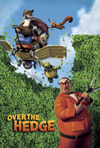 Today (May 19) marks the release of DreamWorks Animation’s computer animated feature film Over the Hedge. With a respectable 64% on the Rotten Tomatoes meter and word that it has tested higher with test audiences than either Shrek film Over the Hedge appears to be in for a good showing at this weekend’s box office. Chris Hewitt of the St. Paul Pioneer Press reports, “This witty and wise comedy is easily the most thoroughly enjoyable animated movie since The Incredibles,” while Erik Childress from efilmcritic.com states, “Its animators have really brightened things up arguably outdoing even the Shrek films for visual astuteness, making this the closest any studio has gotten to Pixar’s dominating perfection.”
Today (May 19) marks the release of DreamWorks Animation’s computer animated feature film Over the Hedge. With a respectable 64% on the Rotten Tomatoes meter and word that it has tested higher with test audiences than either Shrek film Over the Hedge appears to be in for a good showing at this weekend’s box office. Chris Hewitt of the St. Paul Pioneer Press reports, “This witty and wise comedy is easily the most thoroughly enjoyable animated movie since The Incredibles,” while Erik Childress from efilmcritic.com states, “Its animators have really brightened things up arguably outdoing even the Shrek films for visual astuteness, making this the closest any studio has gotten to Pixar’s dominating perfection.”
We present you with a guest review, exclusive interviews with three of the voice actors, and some of the official production notes.
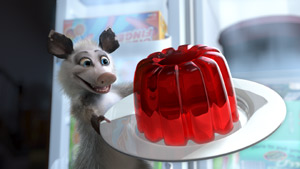
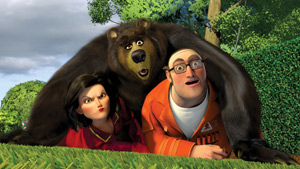
Review
The following is a review written by Animated News guest writer Rachael Reynolds:
If you like adorable animals, comedy, and misadventure as much as I do, then you’ll love Over the Hedge! I was immediately captured by the heartfelt emotions these creature characters portrayed. I never stopped giggling at the many mishaps posed by their struggles of living in the wild, as well as, laughing at suburban human behavior as seen through the eyes of RJ the Raccoon, voiced by Bruce Willis. This film’s impeccable comedic timing gave a pleasant new inflection to the all-familiar one-liners. The dialogue and deft musical cues added insight and kept my undivided attention. How can you deny a group of animals, from possums to baby porcupines, taking back what’s theirs from the encroaching suburbanites? With Thomas Hayden Church voicing The Verminator, the overeager exterminator, and Wanda Sykes as the woefully-independent skunk, the casting couldn’t have been a better fit. Steve Carrel adopted the role of Hammy the spirited squirrel so gleefully, you can’t help but enjoy his sincerity and newfound adoration for cookies. William Shatner and Avril Lavigne as a possum/daughter duo were a welcome surprise, but in the end Gary Shandling as Verne the Turtle takes the animated stage with his words of wisdom and family. This is the animation movie experience I’d been waiting for, and can’t wait to have again!
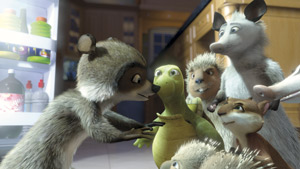
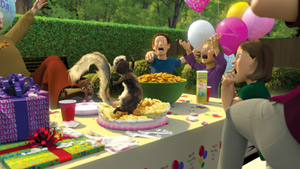
Interviews
The following are from roundtable interviews with voice actors Garry Shandling, Wanda Sykes and Bruce Willis, at which Animated News correspondent Christian Ziebarth participated:
Were you allowed to ad lib all the time?
GS: I was allowed to ad lib a lot of the time but a lot of it they couldn’t use. There were a few jokes taken out just because they couldn’t fit them in. One was, “This shell makes me look twenty pounds heavier.”
What was your initial impression of the script?
GS: I was totally befuddled from the get-go. I had done three scenes in a movie they never finished called “Tusker” about an elephant, then they called me and asked me to do this character. They didn’t have the story completed yet so figuring out who this character was and his arc was very tough. That’s what was frustrating. But I actually believe I’m more of a turtle than Verne is. Verne is up walking around on two legs at full speed and doesn’t pull his head into his shell very often but I was always arriving late for recording sessions and apologizing, sometimes walking around on all fours.
So you feel it was appropriate for you to play a turtle?
GS: Not only appropriate but my destiny.
Did you get to record with any of the other actors?
GS: I wanted to do scenes with some other actors, especially Bruce, but everyone’s schedule was all wacky. Maybe everyone else got together without me and I didn’t know it.
Having had the experience now would you do animation again?
GS: I would do it again but I would make sure that the research had been done so everything would be very clear.
I heard you actually had a trash can over your head at one point during recording. Is that true?
GS: Actually, I walked into the studio that way.
How did you accept the assignment?
GS: Jeffrey Katzenberg called me into his office and said, “I’ve been wanting to find a voice for you to do and now we’ve got it.” And he reached into his pocket and literally put a puppet of a turtle on his right hand and a puppet of a raccoon on his left hand and started talking as the characters. And I was alone with him in the room and I said, “Jeffrey, give me a second.” And I went into the corner and thought to myself, “Someone who has that kind of vulnerability and enthusiasm that they would put on a puppet show could get me to do anything.” And I’ve done a lot of stuff. And he did a good job putting on the puppet show. He wasn’t bad.
(Garry promised that there will be more Larry Sanders and Garry Shandling Show DVDs coming out soon [with lots of newly filmed bonus material] and kept wanting to stay and talk with us even though the junket official kept trying to get him to move on to the next room.)
Did you get to improvise at all?
WS: Early on I did a lot of improv but as we got near the end we had to stick to the script more, but it’s hard to improv when I don’t have anything to improv off of, so I tried to stick with the spirit of what was written and just play around with it. But it took me a while to really lock into Stella. It took me a while to get to that place where I’m not just in there screaming dialogue.
BW: I had a lot of room to improv but I was always wondering if I was getting my lines right, if it was what the directors were looking for. If I said it once I said it fifty times, “Is this what you wanted?” But they did steal a lot of my physicality and facial expressions when they animated. And the most difficult thing is to be funny, to try to make people laugh.
How do you feel about making this family-oriented movie?
WS: Well, I hadn’t done anything in the past that I would say is kid-oriented but I’m not sure because they don’t come out to the clubs. I don’t know if it’s the 2-drink minimum that scares them away. But it’s nice to be a part of something that you can see with the whole family.
BW: My kids want to see it and they want to take their friends. They have as much awareness about this as adults have about The Da Vinci Code.
Are there any cartoons from television you remember liking?
WS: I was always a big Looney Tunes fan. Loved Looney Tunes.
BW: It’s all about Looney Tunes. That was the satire at that time.
Production Notes
The following is an excerpt from the official production notes:
Just whose backyard is it, anyway?
Spring has sprung, and Verne and his woodland friends awaken from their long winter’s nap to discover that a large, green hedge has cropped up right through the middle of their once-natural habitat. Enter RJ, an opportunistic raccoon who explains that the world beyond the hedge is “the gateway to the good life” where peculiar creatures called humans live to eat, rather than eat to live. “For humans,” RJ proclaims, “enough is never enough.”
Suspicious and even a little jealous of the charismatic, smooth-talking RJ, the ever-cautious Verne wants to keep his blended family safely on their side of the hedge. But, proving the adage that one man’s garbage is another man’s—or, rather, animal’s—treasure, the manipulative RJ has his own reasons for convincing the woodland band that there is little to fear and everything to gain from their over-indulgent new neighbors. Eventually, RJ and Verne form an unlikely friendship as they and their furry friends learn to coexist with—and even exploit—this strange new world called suburbia.
Heading up an all-star voice cast, Bruce Willis (the “Die Hard franchise, The Sixth Sense) is the voice of the roguish con-artist raccoon named RJ, and Emmy winner Garry Shandling (TV’s The Larry Sanders Show, It’s Garry Shandling’s Show) voices the overly practical turtle named Verne. Rounding out the voice cast of Over the Hedge are: Steve Carell (The 40-Year-Old Virgin, TV’s The Office) as a hyperactive squirrel named Hammy; comedienne Wanda Sykes (TV’s Wanda at Large) as a sassy skunk named Stella; two-time Emmy winner William Shatner (TV’s Boston Legal) as Ozzie, a possum who excels at playing dead with a melodramatic flair; chart-topping recording artist Avril Lavigne as Ozzie’s daughter, Heather; Catherine O’Hara and Eugene Levy (both A Mighty Wind, Best in Show), who are paired as the porcupine couple, Penny and Lou, with a brood of little porcupine mouths to feed; two-time Oscar® nominee Nick Nolte (Affliction, The Prince of Tides) as a bear named Vincent; and Omid Djalili (“Casanova”) as a spoiled housecat named Tiger. On the human side of the hedge, four-time Emmy winner Allison Janney (TV’s The West Wing) plays Gladys, the president of the local homeowners’ association, who isn’t about to see her neighborhood overrun by wildlife; and Oscar® nominee Thomas Haden Church (Sideways) is the voice of “The Verminator,” whom Gladys hires to rid the area of our woodland heroes.
Based on the popular comic strip by Michael Fry and T Lewis, Over the Hedge was directed by Tim Johnson (Antz) and Karey Kirkpatrick (Chicken Run screenwriter), making his directorial debut. Bonnie Arnold (Toy Story, Tarzan) produced the film, with Bill Damaschke serving as executive producer. The screenplay is by Len Blum and Lorne Cameron & David Hoselton and Karey Kirkpatrick.
ABOUT THE PRODUCTION
FROM STRIP TO SCREEN
They eat to live. We live to eat.
They take what they need and use what they take. We take what we want…and then want more.
In fact, the oddest creatures on Earth may very well be us.
For more than 10 years, that has been the view of a pair of unlikely best friends—a raccoon and a turtle—as they have peered into the manufactured and manicured world of suburbia in the popular comic strip Over the Hedge. Written by Michael Fry and illustrated by T Lewis, the strip made its debut in June 1995 and has since shared daily doses of the animals’ wry and often pointed observations about human foibles and fallacies.
Director/screenwriter Karey Kirkpatrick notes, “The comic strip is about a turtle and a raccoon who peer over a hedge to observe human society and then lampoon it with razor-sharp wit. It’s brilliant observational humor told from an animal’s unique point of view.”
Director Tim Johnson remarks, “The comic strip is an inspired funhouse-mirror reflection of what we are as suburbanites, as humanity. It’s from the perspective of the animals that glimpse us through our own backyards and comment on the strangest animals on the face of the Earth, human beings.”
“It’s a great setting because anyone who has a backyard has had some experience with wildlife,” Michael Fry states.
T Lewis offers, “That was certainly my situation. I lived out in the suburbs and would often see squirrels and rabbits in the yard and raccoons scratching at the windows, looking for food.”
Johnson adds that the experience of sharing our backyards with wildlife is a global one and is not exclusive to America’s suburbs. “Whether you’re in the suburbs of Chicago or the suburbs of Paris, whether you live out on a farm or in the middle of the city, there are animals who have had to learn to deal with the fact that humans are pretty much everywhere now. Wherever you are in the world, the species may change, but the hijinks are pretty much the same.”
“You might look at these animals and ask yourself, ‘What are they thinking?’ And what we’re saying is that they’re thinking they want to get into your kitchens and into your refrigerators,” Fry laughs.
Johnson says he was a fan of the comic strip long before he became involved in the film, partly because he had lived some of the story. “I grew up in the suburbs of Chicago and, at the time I started first grade, from the end of my street there were miles and miles of cornfields as far as the eye could see. By the time I graduated high school, those cornfields had been replaced by a housing development, and one past that, and one past that, and another past that. So I went from living on the edge of suburban sprawl to living in the middle of it within a span of 10 years. We didn’t exactly have a hedge, but we did have a bunch of small trees, and in back of that was a field full of possums and raccoons and skunks. So for me, ‘Over the Hedge’ was a chance to dabble in the very world I grew up in, while swapping places with the animals to see the world from their point of view.”
“It felt like a great arena in which to set an animated film,” says Kirkpatrick, who co-wrote the screenplay with Len Blum and Lorne Cameron & David Hoselton. “We were able to take characters who are very cute and lovable for the kids and allow them to offer a satirical commentary on society within the context of the story.”
Johnson points out that the movie Over the Hedge serves as something of a prequel to the long-running comic strip. “We like to say that our story ends where the comic strip began, meaning the comic strip features the sort of ‘odd couple’ friendship that already exists between Verne and RJ. The movie explores how they met in the first place, which allowed us to take a brand new approach to the characters. It was very liberating for us, but we still worked closely with Mike and T to make sure we stayed within the framework of their world.”
“Mike and T were both actively involved in the development of the film; it was an outstanding partnership,” Kirkpatrick agrees. “We would have been fools not to tap into their unique insights. We worked very hard to include their voice, their commentary, their perspective on this world. As we built the story, we always tried to keep the spirit of the comic strip at its heart—the attitude that it has toward our need for wretched excess, for convenience, to have everything bigger, better and faster. What all that looks like to our animal characters and the effect it has on the animals—that’s also at the heart of this film.”
Producer Bonnie Arnold asserts, “Really, it is we who are in the animals’ backyard; they are not in ours. The comic strip and now the movie are about how suburban sprawl impacts the animals’ lives and how they have to adjust to survive in this new environment.”
WOODLAND BAND
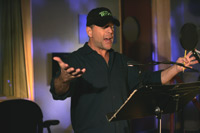
One animal has not just learned to survive but actually to thrive in the paved and pre-packaged world of suburbia. An enterprising raccoon named RJ has found a way to make the other animals’ loss his gain.
Johnson expounds, “A group of woodland creatures awaken from months of hibernation to discover that, where once was a forest there’s a hedge, and beyond that hedge, there is a brand new world they are terrified to venture into. Enter RJ. We call him our raconteur raccoon. He’s a sly character with his own agenda, who’s used to living life on his own and who has never experienced anything like the home and family that Verne and his friends have. We compare RJ to Harold Hill in ‘The Music Man’—a sort of sly con man who comes in and talks a good game, but never quite warns the animals of the perils he’s leading them into.”
Bruce Willis provides the voice of RJ, and Kirkpatrick says he had just the right vocal quality for the role, which was part thief, part huckster and all charm. “RJ needed to be a charming rascal. Bruce has this roguish side to his personality, but he always has this kind of half smile that gives you the sense he’s playing a little bit of a game with you while letting you in on the joke.”
Willis offers, “It was fun to get into the RJ mode. He is a devil-may-care raccoon, the David Addison of the animal kingdom,” the actor adds, referencing the irreverent character that first brought him to fame on the television series Moonlighting. “Over the years, RJ has accumulated all these human items that he carries in a golf bag—his own bag of tricks. It’s all very clever, but the most appealing aspect of the character for me is when he shows his vulnerability. He is really a lonely little raccoon, who runs into this family of animals and finds he wants to be part of them. But the con man in him needs something from them, and a lot of the comedy comes out of the predicaments RJ gets them into. There are a lot of funny things that kids will be able to relate to, but much of the humor was written specifically for the adults. The film makes a strong point about over-consumption, and holds a mirror up to human behavior and society in general in a way that I think everybody is going to find funny.”
“Bruce was a wonderful guy to work with,” Johnson states. “Every session he would ask what else we had learned about the character and how he could bring more to the part. It’s a joy to work with somebody who is not only so passionate about his own performance but also about contributing to the overall picture.”
Unfortunately for Willis’ character, RJ is going to learn a lesson about over-consumption the hard way when he forgets one important rule of nature: only take what you need. Caught stealing a wagonload of food from an angry bear, RJ has exactly one week to pay it all back—right down to the red wagon—or he’ll be dead meat…literally.
“How is he going to do it?” Johnson asks and answers, “Take advantage of these naïve innocents and con them into gathering enough food to repay the bear.”
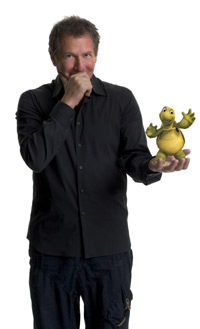
The leader of that group of innocents is a turtle named Verne, who is voiced by Garry Shandling. “Verne is a very practical, cautious turtle, and Garry did a marvelous job of capturing his warmth and family affection, as well as his fear of change and anything new,” Johnson says.
As the de facto head of the forest family, Verne is the first to venture to the other side of the hedge, with disastrous results. He barely makes it back alive, and now, Johnson reports, “Verne looks at suburbia and sees nothing but peril. He never wants to go over that hedge again, but RJ has other plans. He needs the animals’ help to gather a wagonload of food for a hungry bear.”
Shandling offers, “Verne is consumed with protecting his family from this fast-talking fellow, RJ, who just comes in and takes over. Right off the bat, Verne has a bad feeling about him because his tail tingles. When that happens, Verne knows to watch out, and everything RJ says is driving Verne’s tail crazy. Verne has learned to trust his instincts because he is the oldest and wisest of the group. The turtle has been around for millions of years as a species, and they live a long time. I figured Verne to be about 120 years old, but, if I may say, he looks maybe 70, 75 at most…without makeup of course.”
Kirkpatrick notes, “In this role, Garry gives you everything you would expect from him, which is his incredibly smart and wry sense of humor. I don’t think there is anybody better at the subtle undercut. But Verne is also the emotional center of the film, and Garry stepped up to do that very nobly. It was definitely a challenge to find ways for Verne to be as funny as Garry can be without sacrificing the heart and emotion of the story, but he did an amazing job walking that line, just amazing.”
Working on his first animated feature, Shandling states, “The directors, Tim and Karey, really helped me with the character. They were fantastic and very supportive, even though I kept calling Karey ‘Tim,’ and Tim ‘Karey.’ But I used to call my mom ‘Dad,’ and my dad ‘Mom.'”
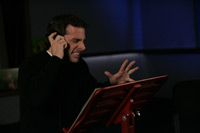
If Verne is the wariest member of the group, the most trusting is Hammy, a hyperactive squirrel who seems to move at the speed of light and, unlike Verne, takes an instant liking to RJ. Johnson comments, “Hammy is a big-hearted character who embraces RJ, this new guy who comes into their midst. He is adorable.”
Steve Carell, who is the voice of Hammy, observes, “Hammy is tremendously loyal to his friends; he is very kind and very loving. It’s going to make me cry just thinking about him because he is the sweetest thing. However, he also has a very short attention span. He will see things and immediately attach himself to that thing, be it food or be it a friend. He is totally fascinated by life, and I think that is one of his best attributes. He lives life to the fullest…amped up about a thousand percent.”
“Hammy is constantly moving,” Johnson affirms. “In fact, we created special effects that sort of vibrate the air whenever Hammy goes by because he moves so fast, but it was Steve who pushed the design of the character with his voice. In computer animation, we connect all of these controls to animate the character. We realized right away that we needed more controls to reflect the range of Steve’s extremely dynamic vocal performance.”
“His ownership of this character was transformative,” Kirkpatrick agrees. “Steve was able to bring all that manic energy to the role, but he also has an inherent sweetness, and the marriage of those two qualities is truly how the character of Hammy came to life. Our sessions with him were almost too short because he was so good.”
“As an actor, the process of recording the role was very exciting because anything was fair game in terms of creating the character and finding out what makes him tick,” Carell says. “Originally, I was just shown thumbnail sketches of what the scenes would be, then I’d come back a few months later and see it all come to life. To see elements of yourself appear in this animated character was a little jarring, I have to admit, because, for one thing, that squirrel is way better looking than I am,” he jokes.

In contrast to Hammy’s sweet optimism, there is Stella, for whom life, in a word, stinks. Kirkpatrick relates, “The first descriptions of Stella were that she is a skunk with attitude. What do you think of when you hear the word ‘skunk’? You think of an animal that stinks. So we thought, if that is the baggage you carry around all your life, it is bound to shape your personality a little bit. You’re bound to be a tad defensive.”
Stella is voiced by Wanda Sykes, who understands her character’s outlook on life. “Stella has every right to be grouchy and to have an edge to her. Who wouldn’t if you just stunk all the time? Stella is great; she gets it. She’s like, ‘These are the cards I’ve been dealt. I’m a skunk. People see me and run away. This is my life. It stinks, but I know it stinks and I’m going to deal with it…but not necessarily on a positive note.'”
Johnson recalls, “When we pitched Wanda the part, she really tapped into the idea that this is a character with a self-esteem problem. Stella’s acerbic humor and quick temper is actually hiding a fear of rejection. She wants to push you away before you push her away.”
“Wanda brought Stella to life with great verve and spunk,” Kirkpatrick remarks. “She was a perfect fit for the role. Wanda has an amazing vocal quality and her attitude has almost become iconic. She is a writer’s dream, because you can give her just about anything to say and she’ll make it funny with the attitude she brings to it. But there is also a vulnerability to Stella, and Wanda played that beautifully as well.”

The softer side of Stella comes out when she finds romance with a domestic housecat she calls Tiger. Tiger holds the key to getting into his house, and his house holds the key to saving RJ’s tail. Sykes explains, “Stella goes through this huge makeover because she has to look like a cat to trick Tiger. She’s hesitant, but she does it to help her family—the group of animals who have always accepted her. But seeing how pretty she looks starts to give Stella more confidence. She looks in the mirror and says, ‘Hey, I’m not that bad.’ She also feels a real connection with Tiger, although she knows she’s not being herself.”
A spoiled purebred Persian cat, Tiger is immediately smitten with the disguised Stella, and even after learning she’s a fake feline, Tiger is undeterred. “When he finds out she’s a skunk and the attraction is still there, Stella knows she’s found her guy. She’s not letting this one get away,” Sykes laughs.
Tiger, whose full name is Prince Tigerius Mahmoud Shabazz, is voiced by actor and comedian Omid Djalili, who says, “Tiger is a ridiculously pompous Persian cat who thinks Stella is a down-and-dirty street cat, but they seem to have chemistry anyway. Basically, Tiger falls in love with a skunk, but he doesn’t care because he can’t smell anyway,” he notes, referring to the “designer” nose of the purebred Persian cat.
Djalili adds that he immediately felt a cultural affinity for the role. “I got a call from my agents saying the people at DreamWorks had seen my work and wanted to meet me for this role. They said the character is Persian, so why not have a real Persian play it? I couldn’t say no.”
Producer Bonnie Arnold offers, “We had heard some voice tapes of Omid and knew he was very funny. We were really excited about him for the role of Tiger and flew him over from London to meet with us about the project. His voice added a different texture to the character, and he was so much fun to work with, too.”
There are two real families within the extended forest family of woodland creatures: the possums, Ozzie and his daughter, Heather; and the porcupine couple, Penny and Lou, and their triplets, Quillo, Bucky and Spike.
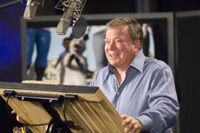
William Shatner is the voice of Ozzie, a possum who excels at—what else?—playing possum. Johnson says, “Possums do in our film what possums do in reality: whenever they are in danger, they play dead. But our possum, voiced by William Shatner, plays dead with a Shakespearean flair. He is a very melodramatic possum.”
Shatner expounds, “Possums don’t have a fight-or-flight mentality. What they do when threatened is drop dead; that’s their defense mechanism. The way they wrote my character, he’s a very Shakespearean possum. He likes to die very theatrically…I don’t know why they chose me.”
“As a longtime fan of William Shatner, it was a real honor to direct him,” notes Johnson. “You will never work with a more energetic, dedicated performer than Bill. The man’s comic timing is consummate. You never have to explain the setup of a joke to Bill; he reads the scene, gets it and will give you 15 different variations on a line, and every one is flawless.”
“I’ve had a lot of radio experience, and doing animation is almost like radio because the only way to reach the audience is through the coloration of your voice,” says Shatner. “You’re in a room taking cues from the director about the context of the line—What’s the situation? What’s the energy? What’s the tempo? There’s also room for improvisation, so it’s great fun.”
“Some of the funniest lines were the ones the actors came up with on the spot,” Kirkpatrick says. “We were very big on letting the actors find the character and own it. That’s when the magic really starts to happen.”
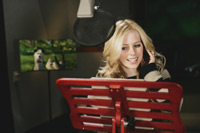
Ozzie has a teenaged daughter named Heather, who doesn’t share her father’s penchant for drama. Johnson says, “Ozzie takes great pride in his species’ ability to play dead to fool his enemies. The problem is that he sees enemies at every turn, so, to Heather’s mortification, Ozzie is flopping over ‘dead’ any time there is a loud noise, or a sudden movement draws his eye. We like to say that every time Ozzie dies, Heather dies a little, too…of embarrassment.”
Chart-topping recording artist Avril Lavigne, who plays Heather, attests, “When Heather’s dad fakes dying, it’s embarrassing to her because she thinks he goes overboard with it. You know, a lot of teenagers get embarrassed by their parents. We all go through it, so maybe a few kids out there will relate,” she smiles.
Although Lavigne is obviously no stranger to working in a recording studio, Over the Hedge marks her acting debut. She remembers, “When the offer came in to do this movie, I thought it would be exciting because the script was great and it was a good part. I came in not really knowing what to expect, and I had a blast. Everyone I worked with was super cool and made me feel very comfortable.”
“Avril is an incredible voice in the world of pop music and a terrific voice in the world of our film,” Johnson notes. “This is her first acting role, but by the end of her first session, Avril didn’t need any advice from us. She gave us a ton of great line readings. As a young woman, Avril still has a finger on the pulse of teenagers today. We wanted Heather to be a girl wrestling with the expectations of her father and this peculiar thing her species does, playing dead. Avril got it immediately and gave so much wit and personality to the character. We were just thrilled to have her in the cast.”
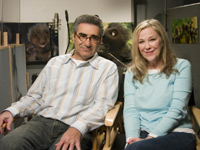
Representing traditional family values are the perfect porcupine parents, Penny and Lou, voiced by two actors who have frequently been paired on the screen, Catherine O’Hara and Eugene Levy. “They’ve known each other for a long time and have worked together before, and their voices complement each other nicely,” Arnold says. “They are both such talented actors and comedians, and they immediately understood what we were looking for in the characters. They brought a lot of warmth and heart to their parts.”
Johnson adds, “We thought of how much fun it would be to unite Catherine and Eugene to play Penny and Lou. They go way back to their Second City days together, so they have a natural chemistry and the kind of rapport that a couple married with children would have. Because they’ve performed together so often, they know each other’s rhythms and comic timing, which was important because, as is usually the case with animation, they did their parts separately.”
O’Hara remarks, “Watching the movie, I was struck by how close the characters seemed—like they had this history together and were having so much fun. I kept remembering that we were not with each other when we recorded the voices, but it really comes off like we were together.”
“You forget for a split second that it’s your voice,” Levy adds. “You can actually detach yourself and just start looking at the film as cute and funny and lovable, and then realize, ‘Hey, that’s me.’ It’s a great feeling to know that I’m in this movie with these other great actors playing furry little characters. I can tell my grandkids, ‘That’s me doing the voice of Lou.'”
Both hailing from Canada, O’Hara and Levy had no problem calling to mind Penny and Lou’s distinctly northern accent. Levy says, “We grew up in Toronto, Canada, where we got American television through a border station in Buffalo. They talk like that there, as well, so it wasn’t unfamiliar to my ear.”
Penny and Lou have the added prickly circumstance of being the parents of a set of mischievous porcupine triplets: Quillo, voiced by Madison Davenport; Spike, voiced by Shane Baumel; and Bucky, voiced by Sami Kirkpatrick, who, being the son of director Karey Kirkpatrick, admittedly had an inside track for the role.
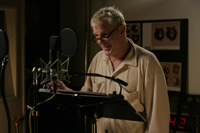
The woodland band is not without enemies, both natural and manmade. On their side of the hedge, there is Vincent, a large bear with an appetite to match. Before going into hibernation, Vincent had stockpiled enough junk food to keep himself fat and happy for many months—that is until RJ tried to make off with his cache and ended up accidentally destroying it. Now Vincent has given RJ one week to recoup his losses or Vincent will be forced to resort to a different food group.
Nick Nolte, who provides the voice of Vincent, asserts, “Vincent is not a bad guy, he just has a little behavior problem. When anyone steals his food, he gets angry…and who can blame him?”
“When we approached Nick Nolte to voice Vincent, he was truly surprised. In his gravelly voice, he asked, ‘Now why would you want me to be a bear?” Johnson laughs. “The role was his the moment we met him. He is an actor who really understands subtext and totally wraps his brain around a character. He brought such an incredible richness to the role.”
Another cast member making his animation debut, Nolte states, “In 40 years of doing films, this was the first time that I had no idea what my character would look like. I found the process to be quite interesting. It was much more collaborative and directorial than I expected it to be, which was very helpful because the directors were with the characters for so long and knew them better than anyone.”

On the suburban side of the hedge, the animals face a new kind of enemy in the person of Gladys Sharp, the by-the-book president of the El Rancho Camelot Estates Homeowners Association, who lives and dies by the rules that keep her community in perfect order. Kirkpatrick says, “The character of Gladys was a way for us to take a not-so-subtle jab at the homogeny that results from development—the push towards uniformity and to squelch individuality. Gladys is obsessed with appearances, and she is there to enforce the rules.”
Lending her voice to the character of Gladys, Allison Janney agrees, “Gladys is a stickler for rules and regulations. What makes her happy is having a tightly run ship. She gets very upset when things get messy, and what messes things up more than raccoons in your trash cans? She is trying to maintain this wonderful community where everything is perfect and clean and beautiful, and these animals come along and threaten to destroy it. Gladys sees her neighborhood being overrun by vermin, and it’s up to her to get rid of these vicious animals.”
Bonnie Arnold comments, “We all know Allison Janney from ‘The West Wing,’ and she has done a lot of drama, but I don’t think many people know how funny she can be. She was up for anything; the more outrageous the character became, the more she relished in the role. We laughed a lot when Allison was in the studio.”
“I think doing animated films is one of the greatest jobs for an actor,” Janney states, “and it’s especially fun to play the villainess. I love to be silly and do crazy voices and be big and bold. Most of the time, directors are telling me to bring it down, but with this project, whatever I could bring was good…and the more the better.”
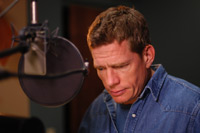
Horrified by what she regards as a virtual vermin infestation, Gladys calls for professional help. She gets more than she bargains for, however, when Dwayne—a.k.a. “The Verminator”—answers the call. A ruthless exterminator with an arsenal of weapons and the world’s worst comb-over, Dwayne is a formidable foe to any animal unlucky enough to be in his sights. Kirkpatrick confirms, “Dwayne is a force to be reckoned with when it comes to the animals. He is utterly committed to pest control, and his nose is so trained that he can take one sniff and know the phylum, genus and species of whatever animals are in range.”
Thomas Haden Church, who provides the voice of Dwayne, remarks, “He is absolutely an arch professional, but given his line of work, you could say he’s inhumane. He is the animal kingdom’s worst nightmare. Gladys is at her wits’ end, so she hires Dwayne to be the answer to her problems, but he just exacerbates things to a whole other level. Dwayne probably solves fewer problems than he creates. He thinks he is the best at what he does, but he may have met his match in these animals.”
Kirkpatrick notes, “Thomas is an amazing talent, but I don’t think any of us were aware of how extraordinary his improv abilities are. I would say that half the lines Dwayne utters are ones that Thomas came up with on the spot. He really helped develop this character and brought him to life in ways that were not on the pages of the script.”
“I had a lot of fun working with Tim and Karey,” Haden Church says. “I thought the lines were funny, the characters were funny… It was just clever and different. I am proud to be part of something so wildly entertaining and original, and at the core of it, there is a genuinely sweet, life-affirming story. That’s what really made me want to be a part of it.”
Bonnie Arnold states, “When you look at our entire cast, it is just an extraordinary ensemble for any movie. We were so thrilled that these remarkable actors all wanted to be a part of this film. Each of them contributed so much, not only to the development of their respective characters but also to the comedy and to the heart of the movie.”

